Korea Pharmaceutical Market Size
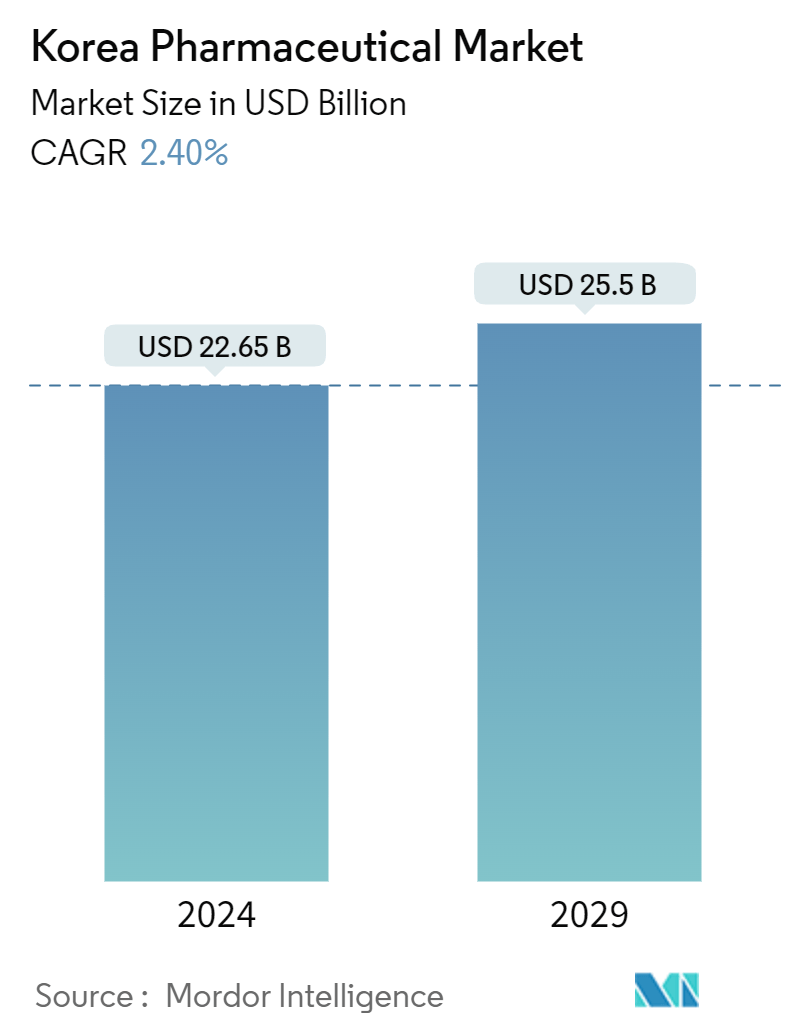
| Study Period | 2019 - 2029 |
| Base Year For Estimation | 2023 |
| Forecast Data Period | 2024 - 2029 |
| Market Size (2024) | USD 22.65 Billion |
| Market Size (2029) | USD 25.5 Billion |
| CAGR (2024 - 2029) | 2.40 % |
Major Players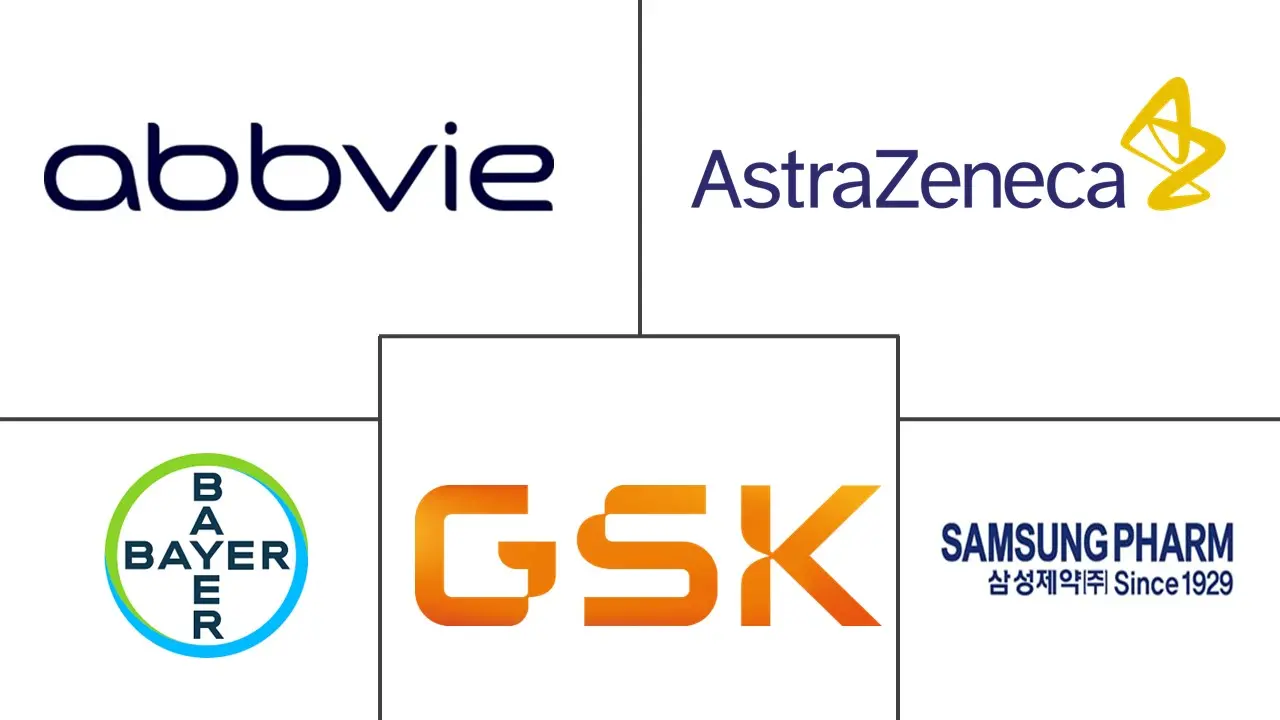
*Disclaimer: Major Players sorted in no particular order |
Korea Pharmaceutical Market Analysis
The Korea Pharmaceutical Market size is estimated at USD 22.65 billion in 2024, and is expected to reach USD 25.5 billion by 2029, growing at a CAGR of 2.40% during the forecast period (2024-2029).
The COVID-19 pandemic affected the healthcare sector. The initial phase of the pandemic has impacted the market significantly due to restrictions on movement, supply chain disruption, travel bans, etc. Although the demand for OTC drugs and prescription drugs decreased during the pandemic, the need for OTC drugs for the common cold and fever increased, which boosted the market's growth. The import of medicinal and pharmaceutical products decreased in 2021 (3,847.1 million) compared to 2020 (4,055.5 million). However, with the released COVID-19 restrictions and resumed import and export activities, the demand for pharmaceutical products is expected to increase over the forecast period.
Factors such as the rising incidence of chronic diseases, such as cardiovascular diseases and diabetes, the increasing geriatric population, and the growing research and development activities and expenditures in the country are expected to drive the market's growth.
The rising number of chronic diseases such as cardiovascular diseases, diabetes, hypertension, cancer, neurological diseases, and others are the key factor driving the market growth. For instance, according to GLOBOCAN, in 2020, there were around 230,317 new cancer cases in South Korea, with 28,713 new cases of stomach cancer, 28,651 prostate cancers, and 25,814 breast cancer. According to the 2022 statistics published by the International Diabetes Federation in the 10th edition of 2021, in South Korea, 3.5 million people were living with diabetes in 2021. As per the same source, this number is projected to reach 3.9 million by 2030. Thus, the expected highly diabetic population is at high risk of developing other chronic diseases, such as liver diseases and kidney and cardiovascular diseases, which is anticipated to boost the demand for pharmaceutical drugs over the forecast period.
The rising geriatric population is contributing to the growth of the market studied. For instance, according to the 2022 statistics published by the United Nations Population Fund, in South Korea, a large proportion of the living population is aged 15-64 and accounts for 71% of the total population in 2022. As per the same source, 17% of the population is aged 65 years and above in 2022. Thus, the rising geriatric populations are more prone to develop chronic diseases such as cardiovascular diseases, neurological disorders, and cancer, raising the demand for effective therapeutics, which accelerates the company's research and development activities to develop drugs and medicines along with other pharmaceutical products., thereby propelling the market's growth.
The increasing government initiatives to launch awareness programs to educate people regarding cancer and other chronic diseases contribute to the market's growth. For instance, the Korean Breast Cancer Society announced the Global Breast Cancer Conference 2023 (GBCC 2023), which will be held in April 2023 in Korea. Such activities are expected to significantly boost the demand for cancer drugs and vaccines, propelling the market's growth.
The growing research and development spending in the country creates opportunities for the company to increase its R&D activities to develop advanced and effective therapeutic or biological drugs and vaccines for treating chronic diseases. This is expected to increase the availability of pharmaceutical drugs in the market, boosting the market's growth. For instance, as per the Federation of Korean Industries (FKI) 2021 report, 93.1 trillion won (USD 75.4 billion) was spent on research and development activities in the country in 2020, accounting for 4.81% of its GDP.
The rising company focus on developing pharmaceutical products for treating various chronic diseased as the growing adoption of various business strategies such as collaboration, acquisition, partnerships, and increasing product launches in the country is also expected to boost the market's growth over the forecast period. For instance, in February 2022, Pharma Korea Co. Ltd, a South Korean subsidiary of Ono Pharmaceutical Co. Ltd, received approval from the South Korean Ministry of Food and Drug Safety (MFDS) for Opdivo (nivolumab) Intravenous Infusion (Opdivo), a human anti-human PD-1 monoclonal antibody for two adjuvant treatments and three combination treatments. In January 2022, ABL Bio Inc., a clinical-stage biotech company, collaborated and entered into a worldwide license agreement with Sanofi to develop and commercialize a treatment for Parkinson's disease and other potential indications. The treatment, ABL301, is a preclinical stage bispecific antibody that targets alpha-synuclein and insulin-like growth factor 1 receptor (IGF1R) with bolstered penetration of the blood-brain barrier.
However, the stringent regulatory scenario is expected to restrain the growth of the pharmaceutical market over the forecast period.
Korea Pharmaceutical Market Trends
The Prescription Drugs Segment is Expected to Hold a Significant Share Over the Forecast Period
The prescription drug segment is expected to hold the largest proportion of the pharmaceutical market over the forecast period in the country due to the high burden of chronic disease that is mainly treated by prescription drugs, growing demand, and adoption of prescription drugs among the population and increasing product launches in the country. For instance, in an article published in October 2021, it has been observed that the prevalence of dementia among people aged 65 years or older was 10.25% in 2020, and it is projected to increase to about 15.91% by 2050. Thus, the expected increase in the population suffering from dementia is expected to increase the demand for drugs, propelling the market's growth.
According to the GLOBOCAN 2020 report, about 287,973 new cases of cancer were recorded combinedly in North and South Korea, and as per the same source, this number is projected to reach 432,770 by 2040. Thus, owing to the high burden of chronic diseases, the demand for prescription drugs is expected to be high in the country, and the segment studied is expected to grow.
With the growing demand for pharmaceuticals, the companies operating in the country are engaged in various business expansion activities, such as launching new drugs, filing for new approval applications, and researching and developing agreements. This is anticipated to boost the segment's growth and the availability of prescription pharmaceuticals in the country. For instance, in December 2021, Pfizer received approval from the South Korean authorities for its antiviral prescription of viral pills against COVID-19. This is expected to to boost the growth of the segment as it will increase the availability of prescription pharmaceuticals in the country.
Therefore, owing to the above-mentioned factors, the prescription drugs segment is expected to grow over the forecast period.
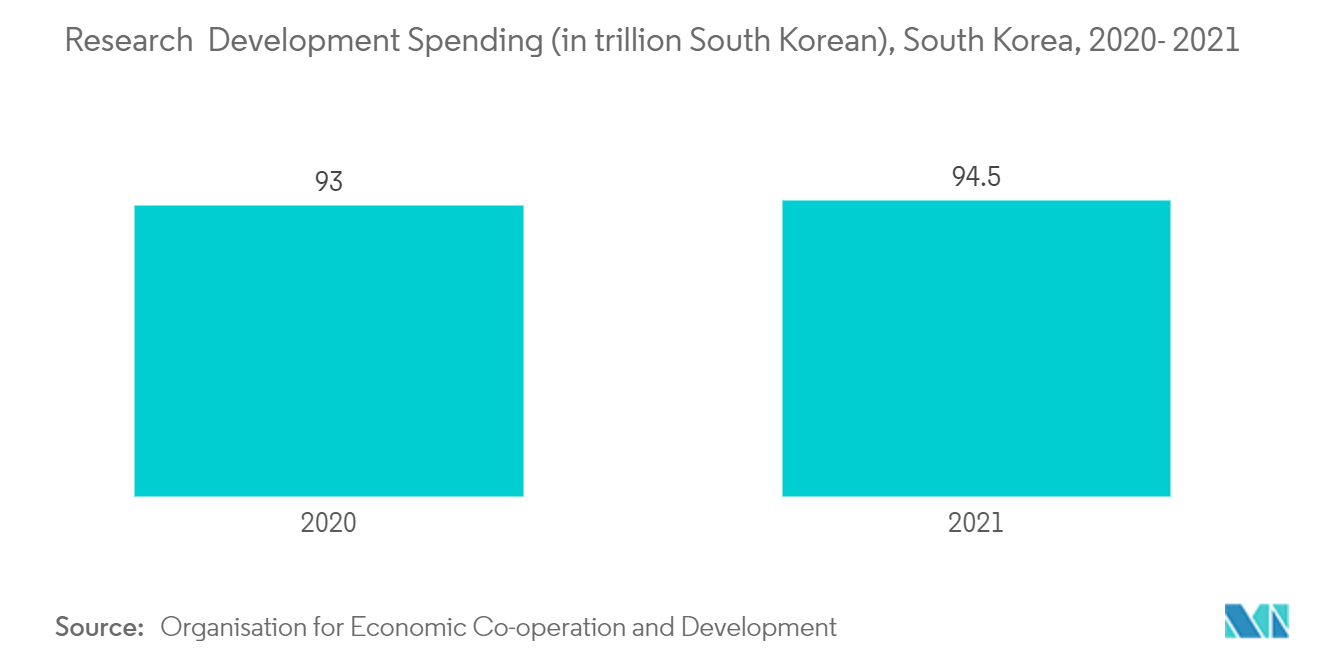
Respiratory System Segment is Expected to Have the Significant Market Share Over the Forecast Period
The respiratory segment is expected to grow over the forecast period, owing to factors such as the increasing prevalence of respiratory diseases such as asthma, chronic obstructive respiratory diseases, and others. The rising pediatric and aging population is more susceptible to developing respiratory diseases due to weak immunity. For instance, an article published in the Journal of Thoracic Disease in April 2021 observed that the prevalence of chronic obstructive pulmonary disease was highest in people aged 60 years or over, followed by people aged 40 years or over in South Korea. Thus, the high burden of respiratory diseases among the population is anticipated to increase the demand for COPD drugs, propelling the market's growth.
The rising company activities in developing drugs are expected to increase the market's growth. For instance, in October 2022, Merck Biopharma Korea launched Tepmetko, a treatment for non-small cell lung cancer, in Korea. The increasing drug approvals in the country are also contributing to the market's growth. For instance, in October 2022, Ono Pharmaceutical, Korea received support for Opdivo (nivolumab) Intravenous Infusion (Opdivo), a human anti-human PD-1 monoclonal antibody (mAb), from the Ministry of Food and Drug Safety (MFDS) in South Korea, for neoadjuvant treatment of adult patients with resectable non-small cell lung cancer in combination with platinum-doublet chemotherapy. In September 2022, the Ministry of Food and Drug Safety approved Boryung's Zepzelca for treating small-cell lung cancer in Korea.
Therefore, due to the factors mentioned above, the segment studied is expected to grow over the forecast period.
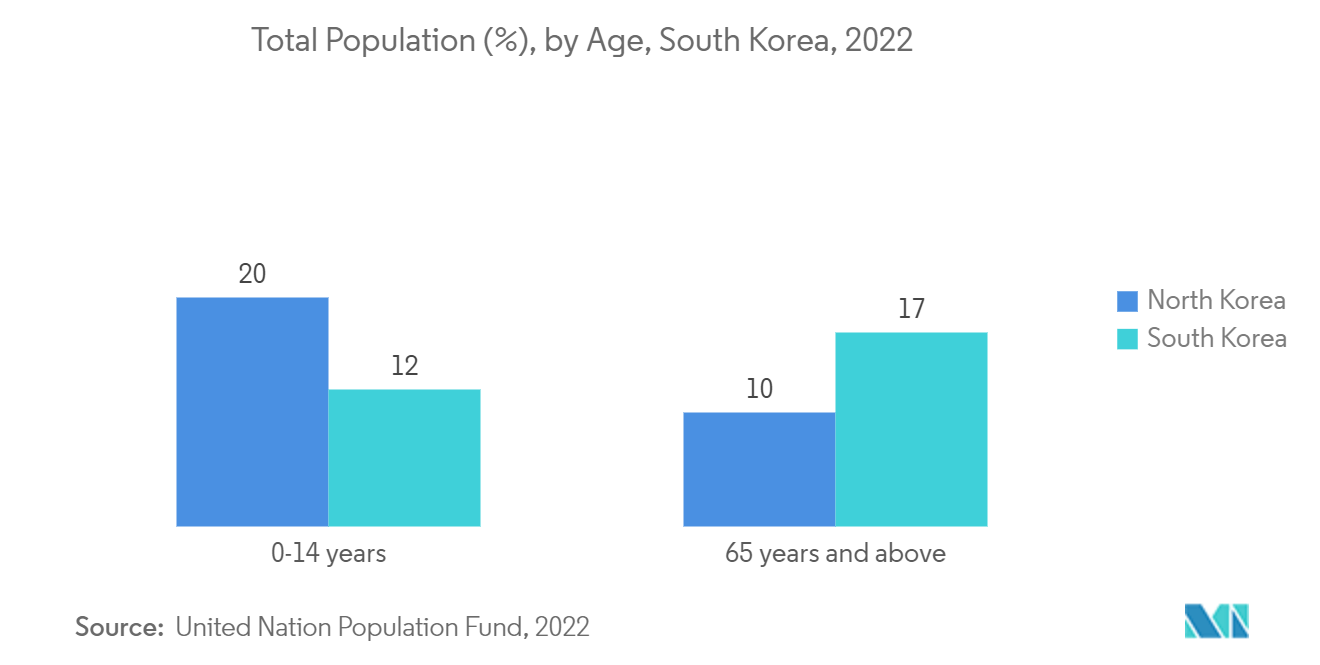
Korea Pharmaceutical Industry Overview
The Korean pharmaceutical market is highly competitive and consists of several major players. A few major players dominate the market in terms of market share. Some prominent players are vigorously making acquisitions and joint ventures with other companies to consolidate their market positions in the country. The key companies dominating the market are AbbVie Inc., AstraZeneca PLC, Bayer AG, and SAMSUNG PHARM. Co. LTD, GlaxoSmithKline PLC, F. Hoffmann-La Roche AG, Bristol Myers Squibb Company, Eli Lilly and Company, Merck & Co. Inc., and Sanofi SA.
Korea Pharmaceutical Market Leaders
-
AbbVie Inc.
-
AstraZeneca plc
-
Bayer AG
-
SAMSUNG PHARM. Co., LTD.
-
GlaxoSmithKline plc
*Disclaimer: Major Players sorted in no particular order
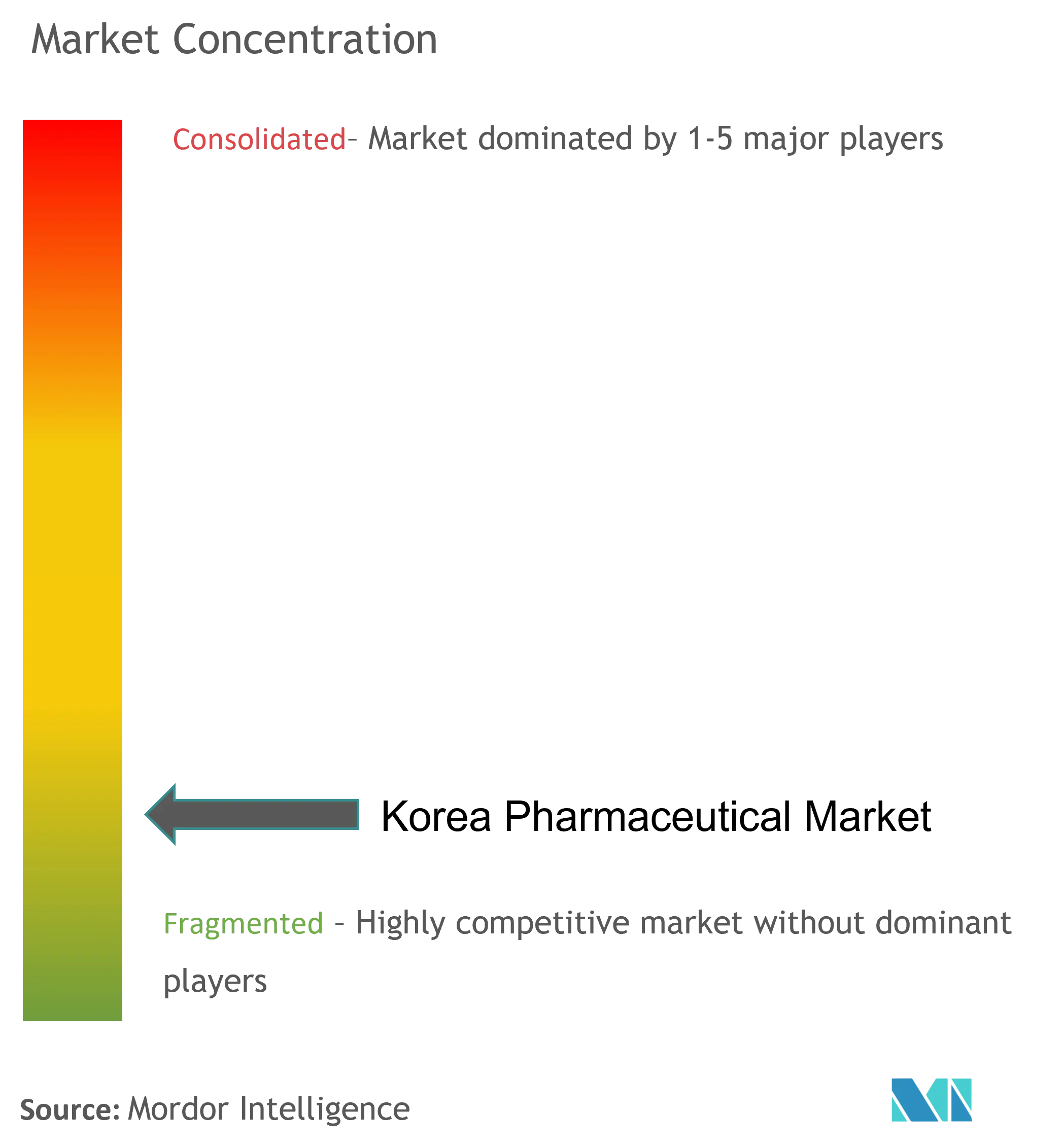
Korea Pharmaceutical Market News
- In November 2022, the Korean the Ministry of Food and Drug Safety approved the combined administration of platinum-based chemotherapy and Opdivo as neoadjuvant therapy before surgery in non-small cell lung cancer patients with tumors that can be resected (tumor size greater than four centimeters or benign lymph nodes).
- In May 2022, Dr. Reddy's Laboratories signed an exclusive partnership deal with the South Korean firm HK inno. N Corporation for the commercialization of the latter's novel molecule Tegoprazan, which is indicated for gastrointestinal diseases, in India and select emerging markets.
Korea Pharmaceutical Market Report - Table of Contents
1. INTRODUCTION
- 1.1 Study Assumptions and Market Definition
- 1.2 Scope of the Study
2. RESEARCH METHODOLOGY
3. EXECUTIVE SUMMARY
4. MARKET DYNAMICS
-
4.1 Market Overview
- 4.1.1 Healthcare Expenditure
- 4.1.2 Pharmaceutical Imports and Exports
- 4.1.3 Epidemiology Data For key Diseases
- 4.1.4 Regulatory Landscape/Regulatory Bodies
- 4.1.5 Licensing and Market Authorization
- 4.1.6 Pipeline Analysis
- 4.1.6.1 By Phase
- 4.1.6.2 By Sponsor
- 4.1.6.3 By Disease
- 4.1.7 Statistical Overview
- 4.1.7.1 Number of Hospitals
- 4.1.7.2 Employment in the Pharmaceutical Sector
- 4.1.7.3 R&D Expenditure
- 4.1.8 Ease of Doing Business
-
4.2 Market Drivers
- 4.2.1 Rising R&D Expenditure
- 4.2.2 Rising Incidence of Chronic Disease such as CVD and Diabetes
-
4.3 Market Restraints
- 4.3.1 Stringent Regulatory Scenario
-
4.4 Porter's Five Force Analysis
- 4.4.1 Threat of New Entrants
- 4.4.2 Bargaining Power of Buyers/Consumers
- 4.4.3 Bargaining Power of Suppliers
- 4.4.4 Threat of Substitute Products
- 4.4.5 Intensity of Competitive Rivalry
5. MARKET SEGMENTATION (Market Size by Value - USD million)
-
5.1 By Therapeutic Category
- 5.1.1 Anti-Infectives
- 5.1.2 Cardiovascular
- 5.1.3 Gastrointestinal
- 5.1.4 Anti Diabetic
- 5.1.5 Respiratory
- 5.1.6 Other Therapeutic Categories
-
5.2 By Drug Type
- 5.2.1 Prescription Drug
- 5.2.1.1 Branded Drugs
- 5.2.1.2 Generic Drugs
- 5.2.2 OTC Drugs
6. COMPETITIVE LANDSCAPE & COMPANY PROFILES
-
6.1 Company Profiles
- 6.1.1 AbbVie Inc.
- 6.1.2 AstraZeneca PLC
- 6.1.3 Bayer AG
- 6.1.4 SAMSUNG PHARM. Co. LTD
- 6.1.5 GlaxoSmithKline PLC
- 6.1.6 F. Hoffmann-La Roche AG
- 6.1.7 Bristol Myers Squibb Company
- 6.1.8 Eli Lilly and Company
- 6.1.9 Merck & Co. Inc.
- 6.1.10 Sanofi SA
- *List Not Exhaustive
7. MARKET OPPORTUNITIES AND FUTURE TRENDS
** Subject To AvailablityKorea Pharmaceutical Industry Segmentation
As per the scope of this report, pharmaceuticals are referred to as prescribed and non-prescription drugs. These medicines can be bought by an individual with or without the doctor's prescription and are safe for consumption for various illnesses with or without the doctor's consent.
The Korean pharmaceutical market is segmented by therapeutic category (anti-infectives, cardiovascular, gastrointestinal, anti-diabetic, respiratory, and others) and drug type (prescription drugs (branded drugs and generic drugs) and over-the-counter drugs). The report offers the value (in USD million) for the above segments.
| By Therapeutic Category | Anti-Infectives | |
| Cardiovascular | ||
| Gastrointestinal | ||
| Anti Diabetic | ||
| Respiratory | ||
| Other Therapeutic Categories | ||
| By Drug Type | Prescription Drug | Branded Drugs |
| Generic Drugs | ||
| By Drug Type | OTC Drugs |
Korea Pharmaceutical Market Research FAQs
How big is the Korea Pharmaceutical Market?
The Korea Pharmaceutical Market size is expected to reach USD 22.65 billion in 2024 and grow at a CAGR of 2.40% to reach USD 25.5 billion by 2029.
What is the current Korea Pharmaceutical Market size?
In 2024, the Korea Pharmaceutical Market size is expected to reach USD 22.65 billion.
Who are the key players in Korea Pharmaceutical Market?
AbbVie Inc., AstraZeneca plc, Bayer AG, SAMSUNG PHARM. Co., LTD. and GlaxoSmithKline plc are the major companies operating in the Korea Pharmaceutical Market.
What years does this Korea Pharmaceutical Market cover, and what was the market size in 2023?
In 2023, the Korea Pharmaceutical Market size was estimated at USD 22.11 billion. The report covers the Korea Pharmaceutical Market historical market size for years: 2019, 2020, 2021, 2022 and 2023. The report also forecasts the Korea Pharmaceutical Market size for years: 2024, 2025, 2026, 2027, 2028 and 2029.
What are the top growth opportunities in the Korean Pharma Market?
The top growth opportunities in the Korean Pharma Market are a) Biosimilars b) Contract manufacturing
What are the top growth opportunities in the Korean Pharma Market?
The top growth opportunities in the Korean Pharma Market are a) Biosimilars b) Contract manufacturing
Korea Pharmaceutical Industry Report
The Korea Pharmaceutical Industry is experiencing considerable growth, primarily driven by the prescription drug segment. This growth is fueled by the increasing prevalence of chronic diseases such as cardiovascular disorders, diabetes, and cancer, particularly in the aging population that necessitates continuous medical care. Additionally, respiratory ailments continue to propel the sector's expansion.
Significant investments in research and development are essential to the success of Korean pharmaceutical companies, promoting drug innovation and development in response to market needs. Government initiatives that support disease awareness further bolster the industry's growth prospects. Moreover, strategic business activities including collaborations, acquisitions, and product launches play crucial roles, though the industry must navigate stringent regulatory frameworks.
Industry analysis reveals that the market is segmented by therapeutic category and drug type, with the value provided in USD million for the above segments. The industry outlook is promising, with industry trends indicating a positive trajectory. Industry reports provide comprehensive insights into the South Korea pharmacy market outlook, helping stakeholders make informed business decisions.
Market data shows a significant market growth driven by the prescription drug segment. The market forecast suggests continued expansion, supported by industry research and development efforts. Market leaders are actively engaging in strategic business activities to maintain their competitive edge.
The industry size and industry statistics highlight the substantial growth rate within the sector. The market overview and market value demonstrate the industry's robust performance. Market segmentation and market review offer detailed analysis of different therapeutic categories and drug types.
For those interested in a deeper dive into this growing market, report pdf downloads are available. These reports include industry information, industry sales, and industry research, providing valuable insights into the market predictions and market outlook. Research companies play a crucial role in compiling these industry reports, ensuring accurate and up-to-date information for stakeholders.
In conclusion, the Korea Pharmaceutical Industry is poised for continued growth, driven by increasing demand for prescription drugs, significant investments in research and development, and supportive government initiatives. The industry analysis, market data, and comprehensive industry reports provide a clear picture of the market trends and future prospects, making it an attractive sector for investment and strategic business activities.



